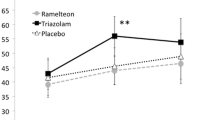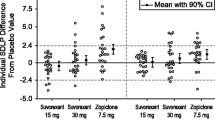Abstract
The study was conducted according to a nineway, observer- and subject-blind, cross-over design. Its purpose was to compare the single-dose effects of the following drugs on driving performance: acrivastine (8, 16 and 24 mg); the combination of acrivastine (8 mg) with pseudoephedrine (60 mg); terfenadine (60, 120 and 180 mg); diphenhydramine-HCL (50 mg); and placebo. The subjects were 18 healthy female volunteers. Drug effects were assessed in two repetitions of two driving tests (highway driving and car-following) after each treatment.
Acrivastine's impairing effects in both driving tests were similarly dose-related. The 8-mg dose had a small, but significant, effect on highway driving in the first trial. The 16-mg and 24-mg doses significantly impaired driving in both tests during the first trial and the 24-mg dose did so again during the second trial.
Neither the combination of acrivastine with pseudoephedrine nor terfenadine caused any significant impairment of performance.
Diphenhydramine significantly impaired driving in both tests during every trial.
In conclusion, the normal therapeutic dose of acrivastine (8 mg) had little effect on driving performance, and virtually none when that dose was given in combination with pseudoephedrine (60 mg). Higher doses of acrivastine severely impaired driving performance. Terfenadine had no significant effect on driving performance after any dose while diphenhydramine strongly impaired every important driving parameter.
Similar content being viewed by others
References
Bhatti JZ, Hindmarch I (1989) The effects of terfenadine with and without alcohol on an aspect of car driving performance. Clin Exp Stud Allergy 19:609–611
Borkenstein BF, Crowther RF, Schumate RP, Ziel WB, Zylman R (1964) The role of the drinking driver in traffic accident. Department of Police Administration, Indiana University, Bloomington, Indiana
Brookhuis KA, Volkerts ER, O'Hanlon JF (1987) The effects of some anxiolytics on car-following performance in real traffic. In: Noordzij PC, Roszbach R (eds) Alcohol, drugs and traffic safety-T86. Elsevier, Amsterdam, pp 223–226
Cohen AF, Hamilton MJ, Philipson R, Peck AW (1985) The acute effects of acrivastine (BW825C), a new antihistamine, compared with triprolidine on measures of CNS performance and subjective effects. Clin Pharmacol Ther 38:381–386
Cohen AF, Hamilton, MJ, Peck AW (1987) The effects of acrivastine (BW825C), diphenhydramine and terfenadine in combination with alcohol on human CNS performance. Eur J Clin Pharmacol 32:279–288
Finn JD, Mattson J (1978) Multivariate analysis in educational research. Applications of the Multivariance program. International Educational Resources, Chicago
Gaillard AWK, Verduin CJ (1983) The combined effects of an antihistamine and pseudoephedrine on human performance. TGO Tijdschr Geneesmiddelenonderzoek/J Drug Res 8:1929–1936
Louwerens JW, Gloerich ABM, Vries G de, Brookhuis KA, O'Hanlon JF (1987) The relationship between drivers' blood alcohol concentration (BAC) and actual driving performance during high speed travel. In: Noordzij PC, Roszbach R (eds) Alcohol, drugs and traffic safery-T86. Elsevier, Amsterdam, pp 183–186
Moser L, Hütner KJ, Koch-Wezer J, Lundt PV (1978) Effects of terfenadine and diphenhydramine alone or in combination with diazepam and alcohol on psychomotor performance and subjective feelings. Eur J Clin Pharmacol 14:417–425
O'Hanlon JF, Haak TW, Blaauw GJ, Riemersma JBJ (1982) Diazepam impairs lateral position control in highway driving. Science 217:79–81
Riedel WJ, Schoenmakers EAJM, O'Hanlon JF (1989) Sedation and performance impairment with antihistamines. In: Kaliner MA (ed) Management of allergy in the 1990s. Huber, Toronto, pp 38–49
Riedel WJ, Ramaekers JG, Uiterwijk MMC, O'Hanlon JF (1990) Higher doses of terfenadine and loratadine: acute and subchronic effects on psychomotor and actual driving performance. Institute for Drugs, Safety and Behavior IGVG 90-08, University of Limburg, Maastricht, The Netherlands
Robbe HWJ, O'Hanlon JF (1990) Effects of acrivastine, acrivastine plus pseudoephedrine and triprolidine on highway driving. Institute for Drugs, Safety and Behavior IGVG 90-01, University of Limburg, Maastricht, The Netherlands
Vuurman FPM, Uiterwijk MMC, Rozensweig P, O'Hanlon JF (1994) Effects of mizolastine and clemastine on actual driving and psychomotor performance in healthy volunteers. Eur J Clin Pharmacology 47:253–259
Winer BJ (1962) Statistical principles in experimental design. McGraw-Hill, New York
Author information
Authors and Affiliations
Rights and permissions
About this article
Cite this article
Ramaekers, J.G., O'Hanlon, J.F. Acrivastine, terfenadine and diphenhydramine effects on driving performance as a function of dose and time after dosing. Eur J Clin Pharmacol 47, 261–266 (1994). https://doi.org/10.1007/BF02570506
Received:
Accepted:
Issue Date:
DOI: https://doi.org/10.1007/BF02570506




